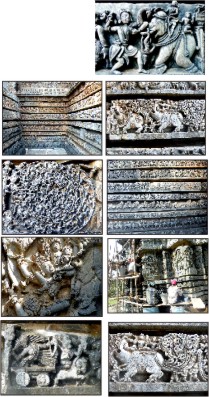These are the days where countries with honest and intelligent rulers are quick to capitalise on their God-given and history created tourist destinations. Even small countries like Seychelles, Maldives, Mauritius and Bhutan, so also many in other parts of the world have more per capita income, GDP and foreign exchange reserve considering their small size compared to many bigger countries like India. It is indeed sad that India, with so many wondrous historical ruins, monuments and scenic nature with the very Himalayas standing tall, is very poor in exploiting the ever increasing tourist business.
To come to the point, I am impelled to write on the subject after listening to the laments of an artist, a well known painter, who had just returned from a visit to Belur and Halebidu, a four hours journey from Mysore.
Belur was the capital of the Hoysala empire near Hassan in Karnataka. The Belur Chennakeshava temple complex embellished with sculptures and carvings of female dancers and scenes from epics and puranas was built by Shantaladevi, herself a danseuse par excellence and queen of the king Vishnuvardhana. The work on the temple was started in 1117 BC and completed later on by Vishnuvardhana’s grandson Veeraballala II, taking some 103 years. The renowned sculptor of the period Jakanachari was credited with the carving of most of the sculptures. There are the sculptures of many celestial beauties from puranas, epics and mythology. According to my friend, the upkeep of the temple complex has always been poor and presently it has worsened.
However, the bad news is from Halebidu, which is 16 kms from Belur. Its earlier name was Dwarasamudra and was the capital of the Hoysala empire and the temple complex has Hoysaleshwara as the main deity. The temple dates back to 1121 BC and is astounding for its wealth of sculptural details. The walls of the temple are covered with an endless variety of depiction from Hindu mythology which includes animals, birds, shilabalikas and dancing figures similar to those found in Belur Chennakeshava temple. It appears this temple took 86 years to complete. This temple is now being proposed as UNESCO World Heritage Site.
Unfortunately, such an important historical and cultural centre of great tourist interest is not looked after with care and concern by the Archeological Survey of India which is entrusted with this task. At the Halebidu temple, my friend saw 20 agricultural labourers perched on scaffoldings, busy cleaning up the sculptures of figurines carved on soap stone [see picture]. They were hired by the authorities on the basis of daily wages.
My friend was aghast looking at the way the scaffolding of wooden poles was constructed. The scaffoldings were held in place by tying them up in ropes around the carved figures of animals and mythological characters [see picture No. 4 above] which would definitely damage the sculptures and it was possible some of the carved images would either get chipped or broken. Such irresponsibility even in such a simple matter of providing scaffolding. These days, scaffoldings made of iron pipes or slotted angles are easily available. These iron scaffoldings stand on their own without being tied to the building, as they have done in the present case.
As regards the cleaning of those images, the authorities do not seem to have applied their mind regarding the liquid and the brush used for the purpose. The so called chemical cleaning seems to be just an excuse to justify billing, says my friend. He found ammonium soap oil was being used and he says the soap stone used in the sculpture will tend to melt gradually. Worse was, they were using a toothbrush for the purpose, which was bound to damage the delicate carvings on the wall.
He also noticed the guides touching the images on the wall while describing them to the tourists. Apparently, they were not qualified and trained guides. In the Sun Temple at Konark in Odisha, much care is taken in this regard to avoid the guides and tourists from touching the statues and figurines, forcing them to keep distance. Rope barricades are used.
According to my friend, the three important temples in this region, namely those at Belur, Halebidu and Somanathapura (which is near Mysore) are built using soap stone and therefore, they need to be well protected from vandalism cau-sed in the manner mentioned above by the tourists and the Department of Archaeology.
In these days of privatisation of many public sector units and public works, the government may well consider outsourcing experts to protect and maintain our ancient heritage structures and ruins to save them for posterity. Otherwise, if they are maintained the way they are maintained today, before long, these temples would become just archaeological sites of ruins and find their place only in our history books and coffee table books. The Government of Karnataka must wake up to the dangers these great heritage temples and other structures are facing and take steps to protect them and not allow civil contractors to destroy them in the name of cleaning, maintenance and restoration.
Tailpiece: My friend had travelled all the way to Halebidu temple to take pictures of the mighty behemoth of an elephant belonging to the lineage of the vehicle of Lord Vishnu, the famed Airavata, being ridden by a king Bhagadatta mentioned in Mahabharata and who fought on the side of Kauravas.
e-mail: kbg@starofmysore.com
source: http://www.StarofMysore.com / Home> Feature Articles / by K.B. Ganapathy / November 12th, 2012
